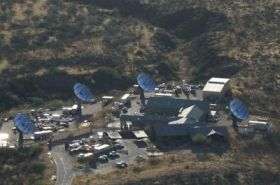New VERITAS telescope array may help find 'dark matter'

Scientists in the Northern Hemisphere have opened a new window on the universe allowing them to explore and understand the cosmos at a much higher level of precision than was previously available. Think of it as acquiring a new pair of glasses that allow you to see more clearly. These new "glasses" are VERITAS, (the Very Energetic Radiation Imaging Telescope Array System), a major new ground-based gamma-ray observatory, designed to provide an in-depth examination of the universe.
VERITAS is an array of four large optical reflectors that detects high-energy gamma rays by observing the light from secondary showers of particles that these gamma rays generate in the atmosphere. The U.S. Department of Energy's Argonne National Laboratory is a collaborator on the program and will provide input to the analysis of the data that the array produces over the next several years.
"It is expected that this instrument will allow for the detection of an increased number of gamma ray sources, possibly even the indirect detection of the mysterious dark matter in the universe," said Karen Byrum, Argonne physicist.
The telescopes are located at a temporary site in the Coronado National Forest in Mt. Hopkins, Ariz., where they will be operated for two years in an engineering mode while a permanent site is acquired. During these two years, a number of key science projects will be undertaken, as well as collaborative observations with the National Aeronautic and Space Administration's next generation gamma-ray space telescope, GLAST, scheduled for launch later this year.
The sensitive instrumentation of VERITAS has an energy threshold for gamma rays of about 100 GeV and can readily identify sources with an intensity of about 1 photon per minute with an observation lasting an hour. This makes it the most sensitive instrument in the northern hemisphere at these energies.
As a collaborator, Argonne participates in the Dark Matter Key Science Project, the Gamma Ray Burst Key Science Project, the Blazar Key Science Project and will assist in research and development for VERITAS upgrades and for the next generation observatory, which is already being planned.
"Through involvement in the VERITAS collaboration, we are examining other ways to look at high energy physics and bringing to the forefront other topics connected to it," explained Hendrik (Harry) J. M. Weerts, director of Argonne's High Energy Physics Division. "The universe with gamma ray bursts, supernovae, and active galactic nuclei, possess nature's most powerful accelerators."
With involvement in the project since its implementation in 1996, David Schramm Postdoctoral Fellow Deirdre Horan serves as Argonne's lead researcher in the collaboration. She hopes to address fundamental physics through the use of this instrumentation, perform more precise observations of black hole systems, and better understand how the universe was formed.
Source: Argonne National Laboratory





















